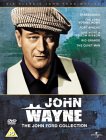 Wayne And Ford - The Collection | DVD | (15/11/2004)
from £N/A
| Saving you £N/A (N/A%)
| RRP
Wayne And Ford - The Collection | DVD | (15/11/2004)
from £N/A
| Saving you £N/A (N/A%)
| RRP A collection of films celebrating the outstanding iconic collaboration of actor John Wayne and director John Ford. Films comprise: 1. Stagecoach (1939) 2. The Long Voyage Home (1940) 3. Fort Apache (1948) 4. She Wore a Yellow Ribbon (1949) 5. Rio Grande (1951) 6. The Quiet Man (1952)
![Bigfoot Trail [DVD]](/pictures/1126861.jpg) Bigfoot Trail | DVD | (05/05/2014)
from £17.53
| Saving you £-4.54 (-34.90%)
| RRP
Bigfoot Trail | DVD | (05/05/2014)
from £17.53
| Saving you £-4.54 (-34.90%)
| RRP In 2013, two filmmakers, Rebecca and Mark, came up with a plan to make a hoax about the mythical 'Bigfoot'. They set up camp in the woods and interviewed locals who claimed to have sighted the beast, documenting each step as they laid the groundwork for their hoax. As night fell however, nothing could have prepared them for the terrifying, and very real events that would follow.
![Freejack [1991]](/pictures/1003542.jpg) Freejack | DVD | (11/02/2002)
from £17.79
| Saving you £-3.80 (N/A%)
| RRP
Freejack | DVD | (11/02/2002)
from £17.79
| Saving you £-3.80 (N/A%)
| RRP An action drama set in the year 2009. A race car driver who is about to die in a crash in 1991 suddenly finds himself alive and transported to the future. But his troubles aren't over: a wealthy man on the verge of death needs the driver's body to stay alive and he'll stop at nothing to get it...
 Maureen O'Hara - Screen Goddess | DVD | (28/08/2006)
from £N/A
| Saving you £N/A (N/A%)
| RRP
Maureen O'Hara - Screen Goddess | DVD | (28/08/2006)
from £N/A
| Saving you £N/A (N/A%)
| RRP The Quiet Man (Dir. John Ford 1952): John Ford's The Quiet Man celebrates one of Hollywood's most romantic and enduring epics. The first American feature to be filmed in Ireland's picturesque countryside Ford richly imbued this masterpiece with his love of Ireland and its people. Sean Thornton is an American who swears off boxing after accidentally killing an opponent. Returning to the Irish town of his birth he finds happiness when he falls in love with the fiery Mary Kate. Though he is sorely tempted to pick up the gloves against her brother the town bully Sean is determined not to use his fists. Mary Kate and Sean wed but her brother refuses to pay the dowry. Sean would rather walk away than accept this challenge. Even when his new wife accuses him of cowardice Sean stands firm. But when she boards a train to leave he is finally ready to take matters into his own hands. Rio Grande (Dir. John Ford 1950): John Wayne and Maureen O'Hara are embroiled in an epic battle with the Apaches and each other in this John Ford classic. Lt Col. Yorke (Wayne) heads to the Rio Grande to fight a warring tribe. But Yorke faces his toughest battle when his unorthodox plan to outwit the elusive Apaches leads to possible court-martial. Locked in a bloody war he must fight to redeem his honour and save his family. Against All Flags (Dir. George Sherman 1952): In 1700 the pirates of Madagascar menace the India trade; British officer Brian Hawke has himself cashiered flogged and set adrift to infiltrate the pirate ""republic."" There Hawke meets lovely Spitfire Stevens a pirate captain in her own right and the sparks begin to fly; but wooing a pirate poses unique problems. Especially after he rescues adoring young Princess Patma from a captured ship. Meanwhile Hawke's secret mission proceeds to an action-packed climax. Rare Breed (Dir. Andrew V. McLaglen 1966): In the 1880s Englishwoman Martha Price (Maureen O'Hara) and her daughter Hilary (Juliet Mills) come to America to sell their prize Hereford bull at an auction. When he is purchased by Bowen a wild Scotsman (Brian Keith) the women hire a footloose cowhand named Burnett (James Stewart) to help them transport the animal to its new owner. So begins an adventure that tests the mettle of all involved as they battle killers cattle stampedes and each other. But when they reach Bowen's ranch even greater obstacles force them to summon up extraordinary courage if they and the prize bull are to survive... Our Man In Havana (Dir. Carol Reed 1959): Jim Wormold (Alec Guinness) a vacuum cleaner salesman in Havana is recruited by the British Intelligence Services. As he has nothing to report he invents facts and pretends to discover secret operations...with disastrous consequences. Carol Reed directs this adaptation of the Graham Greene story. Lady Godiva Of Coventry (Dir Arthur Lubin 1955): Fictionalized account of events leading up the famous nude ride (alas her hair covers everything) of the militant Saxon lady
![The Quiet Man [1952]](/pictures/1013191.jpg) The Quiet Man | DVD | (15/01/2001)
from £20.00
| Saving you £-10.01 (N/A%)
| RRP
The Quiet Man | DVD | (15/01/2001)
from £20.00
| Saving you £-10.01 (N/A%)
| RRP Blarney and bliss, mixed in equal proportions. John Wayne plays an American boxer who returns to the Emerald Isle, his native land. What he finds there is a fiery prospective spouse (Maureen O'Hara) and a country greener than any Ireland seen before or since--it's no surprise The Quiet Man won an Oscar for cinematography. It also won an Oscar for John Ford's direction, his fourth such award. The film was a deeply personal project for Ford (whose birth name was Sean Aloysius O'Fearna), and he lavished all of his affection for the Irish landscape and Irish people on this film. He also stages perhaps the greatest donnybrook in the history of movies, an epic fistfight between Wayne and the truculent Victor McLaglen--that's Ford's brother, Francis, as the elderly man on his deathbed who miraculously revives when he hears word of the dustup. Barry Fitzgerald, the original Irish elf, gets the movie's biggest laugh when he walks into the newlyweds' bedroom the morning after their wedding, and spots a broken bed. The look on his face says everything. The Quiet Man isn't the real Ireland, but as a delicious never-never land of Ford's imagination, it will do very nicely. --Robert Horton
![The Quiet Man/Rooster Cogburn/Stagecoach [DVD] [1938]](/pictures/1097394.jpg) The Quiet Man/Rooster Cogburn/Stagecoach | DVD | (14/09/2009)
from £13.48
| Saving you £-0.49 (N/A%)
| RRP
The Quiet Man/Rooster Cogburn/Stagecoach | DVD | (14/09/2009)
from £13.48
| Saving you £-0.49 (N/A%)
| RRP The Quiet Man (Dir. John Ford 1952): Sean Thornton is an American boxer who swears off the sport after accidentally killing an opponent. Returning to the Irish town of his birth he finds happiness when he falls in love with the fiery Mary Kate. Though he is sorely tempted to pick up the gloves against her brother the town bully Sean is determined not to use his fists. Mary Kate and Sean wed but her brother refuses to pay the dowry. Sean would rather walk away than accept this challenge. Even when his new wife accuses him of cowardice Sean stands firm. But when she boards a train to leave he is finally ready to take matters into his own hands. Rooster Cogburn: (Dir. Stuart Miller) (1975): Two of the most popular stars in screen history are brought together for the first time in the follow up to True Grit. The film returns John Wayne to the role of the rapscallion eye patched whiskey guzzling Deputy Marshall that won him an Academy Award. Katharine Hepburn is prim Eula Goodnight a Bible thumping missionary who teams up with the gun fighter to avenge the death of her father. While in pursuit of the outlaws a warm rapport develops between the rough n' tumble lawman and the flirty reverend's daughter. Stage Coach (Dir. John Ford) (1939): The film is set against the impressive backdrop of Monument Valley in Utah and tells the story of a mixed group of travellers who are making their way across country to Arizona. They are endangered by an Indian War Party and this along with their various characters results in difficulties for the party...
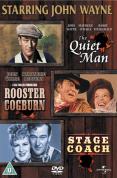 Quiet Man/Rooster Cogburn/Stagecoach | DVD | (19/11/2007)
from £N/A
| Saving you £N/A (N/A%)
| RRP
Quiet Man/Rooster Cogburn/Stagecoach | DVD | (19/11/2007)
from £N/A
| Saving you £N/A (N/A%)
| RRP The Quiet Man (Dir. John Ford 1952): Sean Thornton is an American boxer who swears off the sport after accidentally killing an opponent. Returning to the Irish town of his birth he finds happiness when he falls in love with the fiery Mary Kate. Though he is sorely tempted to pick up the gloves against her brother the town bully Sean is determined not to use his fists. Mary Kate and Sean wed but her brother refuses to pay the dowry. Sean would rather walk away than accept this challenge. Even when his new wife accuses him of cowardice Sean stands firm. But when she boards a train to leave he is finally ready to take matters into his own hands. Rooster Cogburn: (Dir. Stuart Miller) (1975): Two of the most popular stars in screen history are brought together for the first time in the follow up to True Grit. The film returns John Wayne to the role of the rapscallion eye patched whiskey guzzling Deputy Marshall that won him an Academy Award. Katharine Hepburn is prim Eula Goodnight a Bible thumping missionary who teams up with the gun fighter to avenge the death of her father. While in pursuit of the outlaws a warm rapport develops between the rough n' tumble lawman and the flirty reverend's daughter. Stage Coach (Dir. John Ford) (1939): One of the all time classic Westerns - considered by many to be the movie that propelled John Wayne to stardom back in 1939. The film is set against the impressive backdrop of Monument Valley in Utah and tells the story of a mixed group of travellers who are making their way across country to Arizona. They are endangered by an Indian War Party and this along with their various characters results in difficulties for the party...
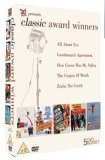 Studio Classic: Classic Award Winners | DVD | (10/10/2005)
from £22.93
| Saving you £12.06 (52.59%)
| RRP
Studio Classic: Classic Award Winners | DVD | (10/10/2005)
from £22.93
| Saving you £12.06 (52.59%)
| RRP All About Eve (Dir. Joseph L. Mankiewicz 1950): From the moment she glimpses her idol at the stage door Eve Horrington (Anne Baxter) moves relentlessly towards her goal: taking the reins of power from the great actress Margo Channing (Bette Davies). The cunning Eve manoeuvres her way into Margo's Broadway role becomes a sensation and even causes turmoil in the lives of Margo's director boyfriend (Gary Merrill) her playwright (Hugh Marlowe) and his wife (Celeste Holm). Only
![The Long Voyage Home [Blu-ray]](/pictures/1163330.jpg) The Long Voyage Home | Blu Ray | (09/06/2023)
from £26.80
| Saving you £N/A (N/A%)
| RRP
The Long Voyage Home | Blu Ray | (09/06/2023)
from £26.80
| Saving you £N/A (N/A%)
| RRP 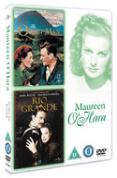 The Quiet Man/Rio Grande | DVD | (26/12/2006)
from £13.99
| Saving you £-1.00 (N/A%)
| RRP
The Quiet Man/Rio Grande | DVD | (26/12/2006)
from £13.99
| Saving you £-1.00 (N/A%)
| RRP The Quiet Man (Dir. John Ford 1952): John Ford's The Quiet Man celebrates one of Hollywood's most romantic and enduring epics. The first American feature to be filmed in Ireland's picturesque countryside Ford richly imbued this masterpiece with his love of Ireland and its people. Sean Thornton is an American who swears off boxing after accidentally killing an opponent. Returning to the Irish town of his birth he finds happiness when he falls in love with the fiery Mary Kate. Though he is sorely tempted to pick up the gloves against her brother the town bully Sean is determined not to use his fists. Mary Kate and Sean wed but her brother refuses to pay the dowry. Sean would rather walk away than accept this challenge. Even when his new wife accuses him of cowardice Sean stands firm. But when she boards a train to leave he is finally ready to take matters into his own hands. The resulting fist-fight erupts into the longest brawl ever filmed followed by one of the most memorable reconciliation's in motion picture history! Rio Grande (Dir. John Ford 1950): John Wayne and Maureen O'Hara are embroiled in an epic battle with the Apaches and each other in this John Ford classic. Lt Col. Yorke (Wayne) heads to the Rio Grande to fight a warring tribe. But Yorke faces his toughest battle when his unorthodox plan to outwit the elusive Apaches leads to possible court-martial. Locked in a bloody war he must fight to redeem his honour and save his family.
 King Frat | DVD | (03/03/2008)
from £10.99
| Saving you £-2.01 (N/A%)
| RRP
King Frat | DVD | (03/03/2008)
from £10.99
| Saving you £-2.01 (N/A%)
| RRP Move over 'Animal House' and 'American Pie' because no film rocks like 'King Frat'! You won't believe the riotous x-rated antics of fat funny and flatulent John DiSanti and the rest of the Pi Kappa Delta crew in the outrageous comedy!
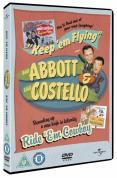 Keep 'Em Flying / Ride 'Em Cowboy | DVD | (28/08/2006)
from £5.99
| Saving you £4.00 (66.78%)
| RRP
Keep 'Em Flying / Ride 'Em Cowboy | DVD | (28/08/2006)
from £5.99
| Saving you £4.00 (66.78%)
| RRP Keep 'Em Flying: When a barnstorming stunt pilot decides to join the air corps his two goofball assistants decide to go with him. Since the two are Abbott & Costello the air corps doesn't know what it's in for. Ride 'Em Cowboy: Two peanut vendors at a rodeo show get in trouble with their boss and hide out on a railroad train heading west. They get jobs as cowboys on a dude ranch despite the fact that neither of them knows anything about cowboys horses or anything else.
![The Woods [DVD]](/pictures/1139467.jpg) The Woods | DVD | (25/04/2016)
from £6.95
| Saving you £6.04 (86.91%)
| RRP
The Woods | DVD | (25/04/2016)
from £6.95
| Saving you £6.04 (86.91%)
| RRP 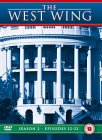 The West Wing - Season 2 Part 2 (Episodes 12 To 22) | DVD | (28/07/2003)
from £N/A
| Saving you £N/A (N/A%)
| RRP
The West Wing - Season 2 Part 2 (Episodes 12 To 22) | DVD | (28/07/2003)
from £N/A
| Saving you £N/A (N/A%)
| RRP The second series of The West Wing, Aaron Sorkin's relentlessly erudite drama about life behind the scenes at the White House, continues here with the emphasis on President Bartlet's multiple sclerosis, a condition that he has hitherto concealed from the American electorate and most of his staff. Tensions grow between himself and the First Lady (Stockard Channing) as she realises, in the episode "Third State of the Union" that he intends to run for a second term in office. It becomes clear to Bartlet (Martin Sheen) that he must go public with his MS, and his staff are forced to come to terms with this, as well as deal with the usual plethora of domestic and international incidents, which apparently preclude any of them from having any sort of private lives, least of all love lives. These include crises in Haiti and Columbia, an obstinate filibuster and a Surgeon General's excessively frank remarks about the drugs situation. Thankfully, the splendid Lord John Marbury (Roger Rees) is on hand to make chief of staff Leo McGarry's life more of a misery in "The Drop-In". These episodes, though occasionally marred by a sentimental soundtrack and an earnest and wishfully high regard for the Presidential office, are masterclasses in drama and dialogue, ranging from the wittily staccato to the magnificently grave, capturing authentically the hectic pace of political intrigue and the often vain efforts of decent, brilliant people to do the right thing. "Two Cathedrals", which features flashbacks to Bartlet's schooldays and his thunderous denunciation of God following a funeral, is perhaps the greatest West Wing episode of all. On the DVD: The West Wing, Series 2 Part 2 features no extras, though the transfer is immaculate. --David Stubbs
![Kennedy [2 Discs]](/pictures/1020146.jpg) Kennedy | DVD | (25/09/2001)
from £N/A
| Saving you £N/A (N/A%)
| RRP
Kennedy | DVD | (25/09/2001)
from £N/A
| Saving you £N/A (N/A%)
| RRP 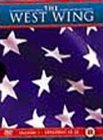 The West Wing - Season 1 Part 2 | DVD | (22/07/2002)
from £N/A
| Saving you £N/A (N/A%)
| RRP
The West Wing - Season 1 Part 2 | DVD | (22/07/2002)
from £N/A
| Saving you £N/A (N/A%)
| RRP Aaron Sorkin's American political drama The West Wing, set in The White House, has won innumerable awards--and rightly so. Its depiction of a well-meaning Democrat administration has warmed the hearts of countless Americans. However, The West Wing is more than mere feel-good viewing for sentimental patriots. It is among the best-written, sharpest, funny and moving of recent American TV series. In its first series, The West Wing established the cast of characters who comprise the White House staff. There's Chief of Staff Leo McGarry (John Spencer), a recovering alcoholic whose efforts to be the cornerstone of the administration contribute to the break up of his marriage. CJ (Alison Janney) is the formidable press spokeswoman embroiled in a tentative on-off relationship with Timothy Busfield's reporter. Brilliant but grumpy communications deputy Toby Ziegler, Rob Lowe's brilliant but faintly nerdy Sam Seaborn and brilliant but smart-alecky Josh Lynam make up the rest of the inner circle. Initially, the series' creators had intended to keep the President off-screen. Wisely, however, they went with Martin Sheen's Jed Bartlet, whose eccentric volatility, caution, humour and strength in a crisis make for such an impressively plausible fictional President that polls once expressed a preference for Bartlet over the genuine incumbent. Handled incorrectly, The West Wing could have been turgid, didactic propaganda for The American Way. However, the writers are careful to show that, decent as this administration is, its achievements, though hard-won, are minimal. Moreover, the brisk, staccato-like, almost musical exchanges of dialogue, between Josh and his PA Donna, for instance, as they pace purposefully up and down the corridors are the show's abiding joy. --David Stubbs
![Nothing Personal [1996]](/pictures/1002332.jpg) Nothing Personal | DVD | (11/08/2003)
from £N/A
| Saving you £N/A (N/A%)
| RRP
Nothing Personal | DVD | (11/08/2003)
from £N/A
| Saving you £N/A (N/A%)
| RRP The deadliest gangsters are those with a cause. Belfast 1975. A bomb goes off in a crowded pub and battle lines are drawn. Loyalist and Republican bosses are negotiating a cease-fire but the foot soldiers want vengeance. Leonard a high-ranking Loyalist orders his men to keep control but gang leader Kenny wants blood. Innocently caught in the cross-fire is Kenny's childhood friend whose involvement places events on a personal level. Tough decisions need to be made as Liam and Kenny find themselves trapped in an escalating spiral of violence from which there is no escape.
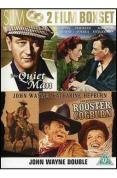 The Quiet Man/Rooster Cogburn | DVD | (26/02/2007)
from £14.83
| Saving you £-1.84 (N/A%)
| RRP
The Quiet Man/Rooster Cogburn | DVD | (26/02/2007)
from £14.83
| Saving you £-1.84 (N/A%)
| RRP The Quiet Man: John Ford's The Quiet Man celebrates one of Hollywood's most romantic and enduring epics. The first American feature to be filmed in Ireland's picturesque countryside Ford richly imbued this masterpiece with his love of Ireland and its people. Sean Thornton is an American who swears off boxing after accidentally killing an opponent. Returning to the Irish town of his birth he finds happiness when he falls in love with the fiery Mary Kate. Though he is sorely tempted to pick up the gloves against her brother the town bully Sean is determined not to use his fists. Mary Kate and Sean wed but her brother refuses to pay the dowry. Sean would rather walk away than accept this challenge. Even when his new wife accuses him of cowardice Sean stands firm. But when she boards a train to leave he is finally ready to take matters into his own hands. The resulting fist-fight erupts into the longest brawl ever filmed followed by one of the most memorable reconciliation's in motion picture history! (Dir. John Ford 1952) Rooster Cogburn: Two of the most popular stars in screen history are brought together for the first time in the follow up to True Grit. The film returns John Wayne to the role of the rapscallion eye patched whiskey guzzling Deputy Marshall that won him an Academy Award. Katharine Hepburn is prim Eula Goodnight a Bible thumping missionary who teams up with the gun fighter to avenge the death of her father. While in pursuit of the outlaws a warm rapport develops between the rough n' tumble lawman and the flirty reverend's daughter. (Dir. Stuart Miller 1975)
 The West Wing - Complete Seasons 1-3 (Amazon.co.uk Exclusive) | DVD | (29/03/2004)
from £N/A
| Saving you £N/A (N/A%)
| RRP
The West Wing - Complete Seasons 1-3 (Amazon.co.uk Exclusive) | DVD | (29/03/2004)
from £N/A
| Saving you £N/A (N/A%)
| RRP This box set containing the complete first three series of The West Wing is available exclusively from Amazon.co.uk. Aaron Sorkin's American political drama The West Wing, set in the White House, has won innumerable awards--and rightly so. Its depiction of a well-meaning Democrat administration has warmed the hearts of countless Americans. However, The West Wing is more than mere feel-good viewing for sentimental patriots. It is among the best-written, sharpest, funniest and moving US TV series of all time. Martin Sheen leads a strong ensemble cast: his Jed Bartlet is such an impressively plausible fictional President that polls once expressed a preference for Bartlet over the genuine incumbent. Handled incorrectly, The West Wing could have been turgid, didactic propaganda for The American Way. However, the writers are careful to show that, decent as this administration is, its achievements, though hard-won, are minimal. Moreover, the brisk, staccato-like, almost musical exchanges of dialogue, between Josh and his PA Donna, for instance, as they pace purposefully up and down the corridors are the show's abiding joy. --David Stubbs
![Deanna Durbin [19 Disc Box Set]](/pictures/1051092.jpg) Deanna Durbin | DVD | (15/11/2004)
from £N/A
| Saving you £N/A (N/A%)
| RRP
Deanna Durbin | DVD | (15/11/2004)
from £N/A
| Saving you £N/A (N/A%)
| RRP A nineteen disc set of films starring Deanna Durbin. Includes: Up in Central Park Hers to Hold Nice Girl? It Started with Eve His Butler's Sister Mad about music Three Smart Girls 100 Men and a Girl Christmas Holiday Because of Him First Love Three Smart Girls Grow Up Can't Help singing The Amazing Mrs Holliday and For the Love of Mary.

Please wait. Loading...
This site uses cookies.
More details in our privacy policy